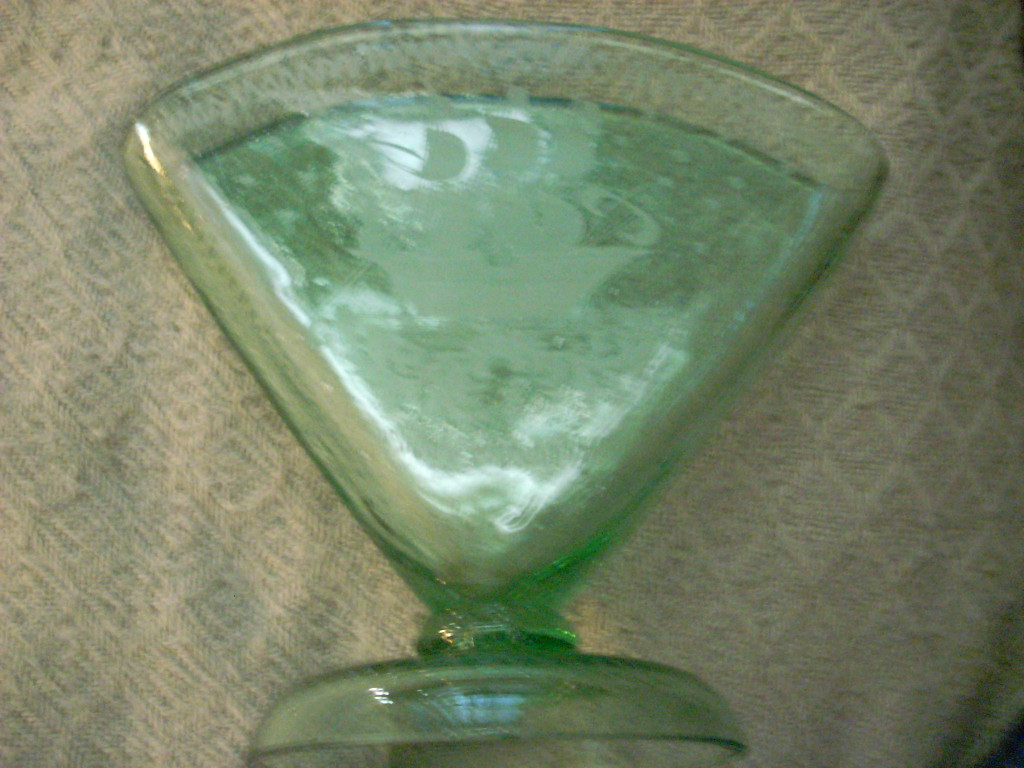So, you're a beginning collector and you picked up some pieces you like and now you want to expand your collection. BUT...someone warned you about "repros". How do you figure out what's new, what's old, what's genuine and what's a repro?
You do what I do, you buy a book and cheat a bit. Meaning, the best reference books will tell you what are reproductions and Gene Florence's Encyclopedia of Depression Glass has some pages in the back where he includes pictures of those and "points" like book collectors use, to detail what the differences are between the GENUINE article and the reproductions. As a glass collector and reseller for 35 years, I couldn't have lived with out this info. So the first thing is use that widget on the right sidebar and buy his book.
Now lets talk quickly about some telling points so you can go to the fleamarket/garage sale today and buy something.
This is Madrid - Federal and Others reproduced it...
Madrid was produced first from 1932 to 1939 by Federal Glass. As they hit the economic hard-times of the 70's (believe me ...it was worse then and we did walk up hill in blizzards to get to work..I was too old for school. I had a crummy job. so I remember) Federal "reissued" this pattern in both Amber and light blue and in pink. The "reissued" (their word not mine) pieces typically but not always had a 76 above the squiggly design element or in the corners of the plates. Then in the 1980's Indiana glass bought the remains of Federal, including their "molds" and designs and reissued more of this pattern but with NO marks to differentiate the old from the new. A bad habit Indiana still has.
Part of the problem with Madrid (which came in Green and Amber. Crystal, Pink and Madonna blue which is the solor of the "save now" button on blogger) is that the amber in particular gets a "muddy" amber color darker more like buckwheat honey than clover honey if you're a honey fan. The plates in particular - which are HUGE plates were "muddy" most of the time from my experience. If what you ahve is a bright clear goldy amber? it's probably new.
Indiana issued it in TEAL, but also in blue pink and crystal. So if you're buying it and it's those colors, I can guarantee it's only 30 years old not 80-100. Not quite vintage let alone antique, ya know? Check the Florence book for more details on the old and the NEW.
This picture above is a "clambroth" jadite refrigerator keeper (bow your head here and pray for the poor departed thing. I dropped it and broke into a million pieces). THIS was an original (til I broke it). The color was a "waxy" almost transparent green. Unlike what Martha Stewart Designs sells now in K-Mart etc.
There are MULITPLE books on this so if you want old, you have to get the books and read 'em cause THIS color has been totally bastardized in the last 20 years both by Martha and the chinese repro artists who know a good selling thing when they see it. And their version looks more like these 2 "bud" vases which are neither vases, budding or old.

Now this amber pattern below is called SHARON - It came in Pink Green and amber. I don't care much for the amber color because on a lot of pieces it got muddier than the Federal Madrid. Meaning it wasn't a bright pretty amber color. It also gets "washed" out. The pink gets orangey but the green is gorgeous. The problem with this pattern is it shows use marks fairly easily. BUT the great thing is? It's not the popular so it's more easily found and it wasn't reproduced. I find the bowls (round 8" Master Berry or Vegetable bowls) more than anything else. The plates I find all seem to be "knife-marked" in the middle where you would cut your food. (logical see? it's all logical)
And cause I have this picture I'm gonna show you this because I have the picture right now and I will lose it before I can post about it.
This is King's Crown (a small sherbet) manufactured by Indiana. King's Crown was made back from the 1891 on. Originally made by US Glass, it was produced in amber-stain, ruby-stained, and crystal. Indiana made it from the 1950's on with a ruby-stain. The main difference, I learned the hard way, is the older US Glass items were apparently a 3 part mold and Indiana's were 2 part molds. (so you'll see either 2 or 3 lines down the sides) And the ruby-stain from Indiana is not as deep and gets scratched more easily.
Ok, next post will be names and links to some great reference books.


























